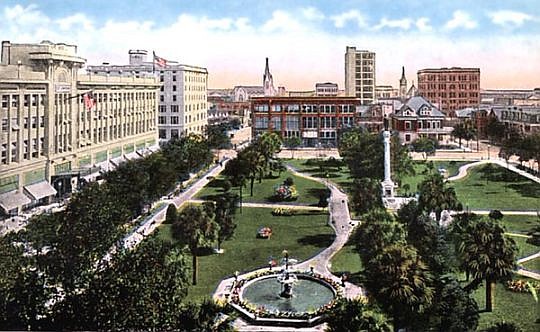
A 2-acre plot of land Downtown the city has owned for more than 150 years is being considered for designation as a landmark.
An ordinance is making its way through City Council committees that would, at the request of the Jacksonville Historic Preservation Commission, place Hemming Park on the list of local historic sites.
Not everyone was on board with the proposal.
When the Parks, Recreation and Community Services Department learned of the intent, a letter was sent to the commission saying the city opposed the designation over concerns it might hinder changes, additions or upgrades to the park, said city spokeswoman Marsha Oliver.
However, the city supports the designation for the 62-foot-high Confederate monument in the fountain in the park near the Skyway station.
It’s actually part of the park’s historical provenance.
According to research presented to the commission by Historic Planner Joel McEachin, the history of Hemming Park goes back to Jacksonville’s beginning.
Around 1859, Isaiah Hart, regarded as the founder of Jacksonville, owned most of the property in what’s now Downtown between the St. Johns River on the south, Hogans Creek on the east and north and Clay Street on the west.
He drew a map laying out the street grid that clearly shows the block surrounded by Duval, Hogan, Laura and Monroe streets was intended to be a public square.
According to McEachin’s report, Hart’s intent in establishing a public square was to increase the value of his property and encourage business development north of Bay Street, which often flooded.
During the Civil War, Union forces occupied Jacksonville in 1862.
By February 1864, Union Army headquarters was in the park near the bandstand.
The city acquired the park in January 1866 when the executors of Hart’s estate sold it for $10 with the provision the block remain forever a public space.
Interest to improve the park by installing permanent fence and constructing a bandstand didn’t develop until three years later, when the St. James Hotel, now City Hall, was built along the north side of the block.
The history of maintenance issues in the park goes back to 1882, when a newspaper editorial described the space as a “municipal eyesore” and predicted the pavilion was in such poor condition it might fall and kill someone.
It was soon described in a newspaper article as “overgrown with weeds, habituated by stray cows and pigs, and a gathering place for ‘bunko men’ and prostitutes.”
In 1895, the city made its first appropriation for the park: $700 for walkways and sinking of a well for a fountain.
President and Mrs. Grover Cleveland stayed in the St. James Hotel in February 1888 while visiting the inaugural Subtropical Exhibition in Jacksonville.
The space got its name in 1899, when City Council voted to designate it “Hemming Park” in recognition of Charles Hemming, who donated the Confederate Monument that stands in the fountain near the Skyway platform.
Since then, the park has been used as a camp for victims of the Great Fire of 1901 and visited by numerous national public figures, including presidents and candidates such as Richard Nixon, Lyndon Johnson and John Kennedy.
Addressing the city’s concern that the designation could hinder future improvements at the park, McEachin said the commission takes a different view of historic parks compared to historic structures, which may not be altered.
He said Hemming Park will join several similar historic sites, such as the park around the fire tower along Beach Boulevard, LaVilla Park west of Interstate 95 and a number of cemeteries.
When considering alterations and improvements, the commission “generally goes lighter on parks,” McEachin said.
The commission plans to consider as landmarks only the Confederate Monument and the marker showing the location of the old Kings Road which are within the space.
Future improvements, such as building retail kiosks or a stage, will not be prohibited.
McEachin said most of the historic park sites have changed over the years and the commission would not deny changes in Hemming Park “as long as it remains a public space.”
(904) 356-2466